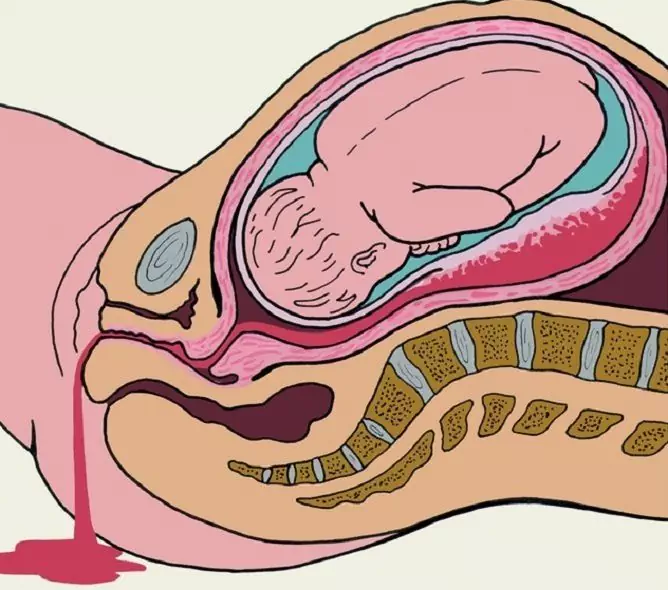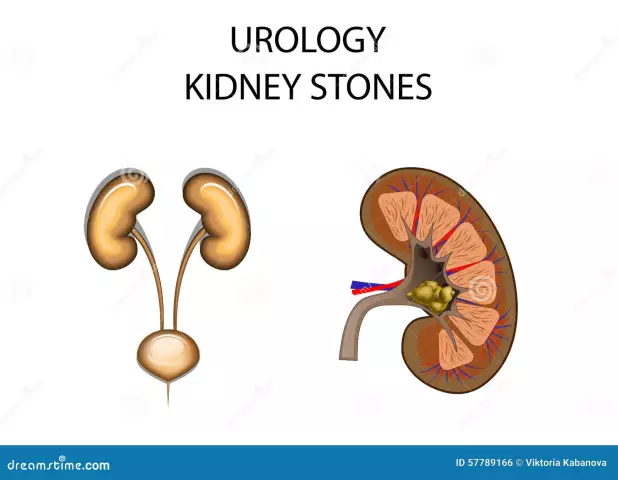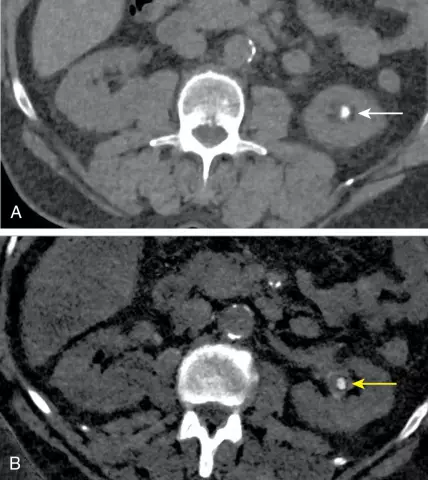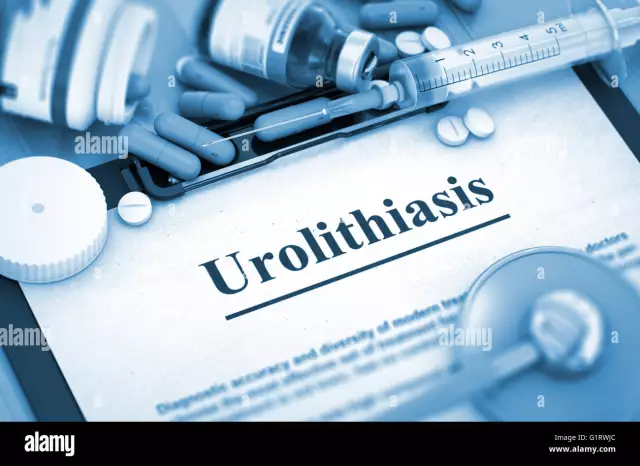- Author Rachel Wainwright [email protected].
- Public 2023-12-15 07:39.
- Last modified 2025-11-02 20:14.
Urolithiasis disease

Urolithiasis (urolithiasis) is a disease resulting from metabolic disorders, in which an insoluble sediment is formed in the urine in the form of sand (up to 1mm in diameter) or stones (from 1mm to 25mm and more). The stones settle in the urinary tract, which disrupts the normal outflow of urine and causes renal colic and inflammation.
According to medical statistics, urolithiasis ranks second in frequency among all urological diseases, and in third place among urological diseases leading to death. Urolithiasis affects people of all ages, including children, but the main age group is people between the ages of 25 and 45. The disease is more common in men than in women, but women are more likely to be diagnosed with severe forms of the disease. It is also known that stones are more often formed in the right kidney than in the left, and in about 20% of cases, both kidneys are involved in the pathological process.
Causes of urolithiasis
Many factors play a role in the occurrence of urolithiasis, while the mechanism of stone formation and its causes are not fully understood. It is known that the leading role is assigned to the structural features of the tubular system of the kidneys, when the anatomical structure of the kidney itself contributes to the occurrence of congestion. At the same time, for the formation of stones, the influence of external factors is also necessary, mainly diet, as well as the conditions of the drinking regime. Also, in the development of urolithiasis, diseases of the genitourinary system, endocrine pathologies (especially diseases of the parathyroid glands, which directly affect metabolic processes involving calcium), long-term intake of certain medicinal substances (sulfonamides, tetracyclines, glucocorticoids, aspirin, etc.) play a role.
Types of urolithiasis
Various metabolic disorders cause the formation of stones that differ in their chemical composition. The chemical composition of calculi is important, since medical tactics in the treatment of urolithiasis depend on this, as well as diet correction to prevent relapse.
The following calculi are formed in the urinary tract:
- Calcium-based stones (oxalates, phosphates, carbonates);
- Stones based on uric acid salts (urates);
- Stones formed by magnesium salts;
- Protein stones (cystine, xanthine, cholesterol).

The main share falls on calcium compounds (about 2/3 of all stones), protein stones are less common. Urata are the only group that lends itself to dissolution. These stones are more common in the elderly. Magnesium stones are most commonly associated with inflammation.
Stones with urolithiasis can form in any part of the urinary tract. Depending on where they are located, the following forms of the disease are distinguished:
- Nephrolithiasis - in the kidneys;
- Ureterolithiasis - in the ureters;
- Cystolithiasis - in the bladder.
Symptoms of urolithiasis
Urolithiasis is initially asymptomatic. The first signs of urolithiasis are found either by accident, during examination, or with sudden renal colic. Renal colic is a severe painful attack, which is often the main symptom of urolithiasis, and sometimes the only one, resulting from a spasm of the urinary duct, or its obstruction by a stone.
The attack begins acutely, with sharp pain, the localization of which depends on the localization of the stone. The pain is intense, can radiate to the groin, lower abdomen, lower back. Urination becomes painful and frequent, and blood is found in the urine (hematuria). There is nausea, sometimes vomiting. The patient rushes about in search of a position that would bring relief, but does not find such a position. An attack of renal colic can pass with a remission and aggravation of pain, and end either with the removal of the stone, or with the subsiding of colic, or with a complication that has developed.
It should be noted that the severity of the signs of urolithiasis is not always associated with the size of the stones. Sometimes small stones, not exceeding 2 mm, can cause severe colic, while there are cases of severe kidney damage, when multiple stones that have grown into coral formations do not lead to colic, but are discovered by chance or when complications of urolithiasis begin.
Diagnosis of urolithiasis
Diagnosis of urolithiasis is based on the characteristic clinical picture of renal colic and ultrasound data. Computed tomography and magnetic resonance urography are also informative. A detailed analysis of urine is carried out, using functional tests (according to Zimnitsky, Nechiporenko, etc.). Bacteriological examination of urine is mandatory. Radiography has now lost its leading place in the diagnosis of urolithiasis, but is still used as an additional method.
Treatment of urolithiasis

An attack of renal colic is relieved with antispasmodic and analgesic drugs. The main treatment of urolithiasis is carried out in the absence of acute manifestations.
Urolithiasis is considered a surgical condition, but urolithiasis caused by urate formation can be treated medically by taking drugs that dissolve the stones. Other types of calculi require mechanical removal.
Treatment of urolithiasis is carried out using two main methods: lithotripsy and surgical. Extracorporeal shock wave lithotripsy is an effective treatment for urolithiasis in which stones in the urinary tract are broken up by a shock wave and then excreted in the urine. The method has proved to be excellent, thanks to it, the indications for surgical intervention in the treatment of urolithiasis have significantly narrowed.
Operations that are used to treat urolithiasis are divided into open and endoscopic, as well as organ-preserving and radical. A radical operation is the removal of the kidney, in the event that it has lost its function. The method of preference in choosing the surgical treatment of urolithiasis is endoscopic techniques that allow the removal of stones without making an incision in the abdominal cavity.
Prevention of urolithiasis
Prevention of urolithiasis is a prerequisite for a complete cure, since without it, relapses are inevitable. The basis for the prevention of urolithiasis is adherence to a diet that normalizes the metabolism and biochemical composition of urine, as well as adherence to the drinking regime. The diet for urolithiasis is developed depending on the chemical composition of the stones. So, with oxalates, dairy products, chocolate are excluded from the diet, and with urate stones, the use of meat is limited. An extremely important condition is the intake of a sufficient amount of water - 1.5 - 2 liters per day.
YouTube video related to the article:
The information is generalized and provided for informational purposes only. At the first sign of illness, see your doctor. Self-medication is hazardous to health!






